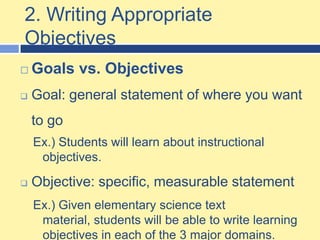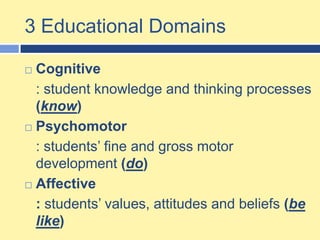Chapter 5 planning inquiry instruction
- 1. Planning and managing inquiry instructionSCED 570, Fall 2011 EaquintoChap5.
- 2. 4 Steps in planning well-designed science lessonsSelect science content that is consistent with state or national content standardsWrite learning objectivesDevelop learning activities Plan assessment tasks and procedures
- 3. 1. Select Science Content NSES: broad goals State standards / District curriculum guides: specific contents FOSS (Full Option Science System)Developing teachers’ knowledge of science Resources: books (textbooks, teachers’ guides, children’s books), internet, other teachers, science specialists, college courses and institutions, conferences, professional development Professional Development (groups)CAST: Colorado Association of Science Teachershttp://coloradocast.org/NSTA: National Science Teachers Association http://www.nsta.org/
- 4. What do they offer?
- 5. Who is their target audience?
- 6. How do they contribute to the P.D. of educators?
- 7. What benefits for you? MAST: Mathematics and Science Teaching Institutehttp://www.mast.unco.edu/
- 8. Email to “webconnect@unco.edu”2. Writing Appropriate ObjectivesGoals vs. Objectives Goal: general statement of where you want to goEx.) Students will learn about instructional objectives.Objective: specific, measurable statementEx.) Given elementary science text material, students will be able to write learning objectives in each of the 3 major domains.
- 9. What are instructional objectives? Specific intended learning outcomes Defined by the teacherUsed to define the learning experienceAre directly linked to assessmentShould address the 3 domains of educational outcomes with 3 main componentsHow do teachers use instructional objectives?Planning, Design assessment, Communicate with students 3 Educational Domains Cognitive : student knowledge and thinking processes (know)Psychomotor : students’ fine and gross motor development (do)Affective : students’ values, attitudes and beliefs (be like)
- 10. 3 Main Components: ABCs of Objectives Audience (who) Behavior (how learning demonstrated)Conditions (activity, reflection, etc.)
- 11. Straw AirplaneCut out both of the paper strips on the handout.Bend the paper strips into a loop and use the tape to stick the two ends together. You should have two loops, one larger than the other.Place one piece of tape at the very end of the straw. Make sure that the tape is sticking out so the straw and the tape look like a capital T. Place the other strip of tape at the other end.Slide one loop over the end of the straw and fasten it to the tape there. Do the same thing on the other side of the straw.Toss your airplane.
- 12. Sample objectives “Using a straw airplane, the student will be able to accurately diagram and explain lift, thrust, and drag.”
- 13. ABCs of Objectives: AudienceIdentify who will be expected to achieve the objectivesLook at the sample: “Using a straw airplane, the student will be able to accurately diagram and explain lift, thrust, and drag.Audience
- 14. ABCs of Objectives: Behavior Identify specific type of performance that will be expectedShould be measurable.Use action verbs – do not use words like know or understand. What does know look like?Look at the sample: “Using a straw airplane, the student will be able to accurately diagram and explain lift, thrust, and drag.Action verbs
- 15. ABCs of Objectives: Condition Identify the context of the performance What materials will student use to complete the task;
- 16. How will students accomplish the task;
- 17. Where the performance will occurLook at the sample: “Using a straw airplane, the student will be able to accurately diagram and explain lift, thrust, and drag.ConditionCriterion(Describes how well the student must perform the desired task.)
- 18. Objectives call for different levels of thinking Verbs used in instructional objectives (class/test questions) call for different levels of thoughtBloom’s Taxonomy (Bloom, 1956) : Provide basis for writing behavioral objectives at different cognitive levelKnowledge: repeat back facts
- 19. Comprehension: interpret, put in own words
- 20. Application: use in new situation
- 21. Analysis: break into parts
- 22. Synthesis: create new pattern
- 23. Evaluation: state and defend opinion based on criteriaWrite your own objectives (class points)Using the activities we have done in the classroom, write at least three objectives for that in each domain:Cognitive
- 24. Psychomotor
- 25. AffectiveUnderline the audience and the behaviors (performance), box the conditions, circle the criterion.
- 26. Four forces on an airplane(From the National Aeronautics and Space Administration (NASA) website)Lift & Drag are mechanical forces generated by a solid object moving through a fluid (gas or liquid)Weight is a forces caused by the gravitational attraction of the Earth. Thrust is a mechanical forces generated by the engines to move the aircraft through the air.
- 27. Balloons RocketAttach a string to the ceiling or wall on the far side of the room.Anchor the string across the room so that it stretches as far as possible.Feed the string through the straw.Blow the balloon up but do not tie it off, and attach it to the straw using the tape.Release the balloon. Record the distance it travels.
- 28. Balloons RocketNewton's Third Law of MotionFor every action, there is an equal and opposite reaction;The forces of two bodies on each otherare always equal and are directed in opposite directions.
- 32. 3. Select and Design Lesson Activities Introduction to the lessons Designed to engage the students in an activity or lesson. (Engage in 5E)Discrepant events A scientific phenomenon that has a surprising or unusual outcome for students to consider.
- 33. May be a teacher demonstration, video or embedded within activities.
- 34. Reveal the alternative conceptions held by learners.
- 35. Try your hand at figuring out this discrepant event…3. Select and Design Lesson Activities Use a variety of lesson activities Learning experiences should be aligned with objectives.
- 36. Should be designed to develop students’ conceptual understanding and inquiry abilities.
- 37. Include a variety of teaching and learning approaches. Activities to develop inquiry abilities3 types of Investigations Open inquiry activitiesStudents are given the problem and materials, and have time and freedom to explore.3. Select and Design Lesson Activities Science learning centersCreated by the teacher for independent activities of students.
- 38. Motivate, guide, and support students’ learning.
- 39. Allow teachers to meet individual needs.
- 40. Provide students with self-directed learning opportunities.
- 41. Various types (e.g., guided discovery learning center) Field trips Create interest and rich learning experiences.
- 42. Key: the advance preparation 4. Designing Assessment Experiences Chapter 6Use both formative and summative assessmentsManaging Inquiry Instruction and Learning Grouping students for learningDiverse structures
- 45. Pair structure
- 47. Building “communities of learners” Safety in the science classroomManaging classroom behaviorEstablish rules, monitor students’ activates, enforce disciplinary consequences Implementing Learning Activities Teacher preparationPre-activity teacher/student activities Distribution and collection of science materialsBeginning the activityDuring the activityAfter the activity


























